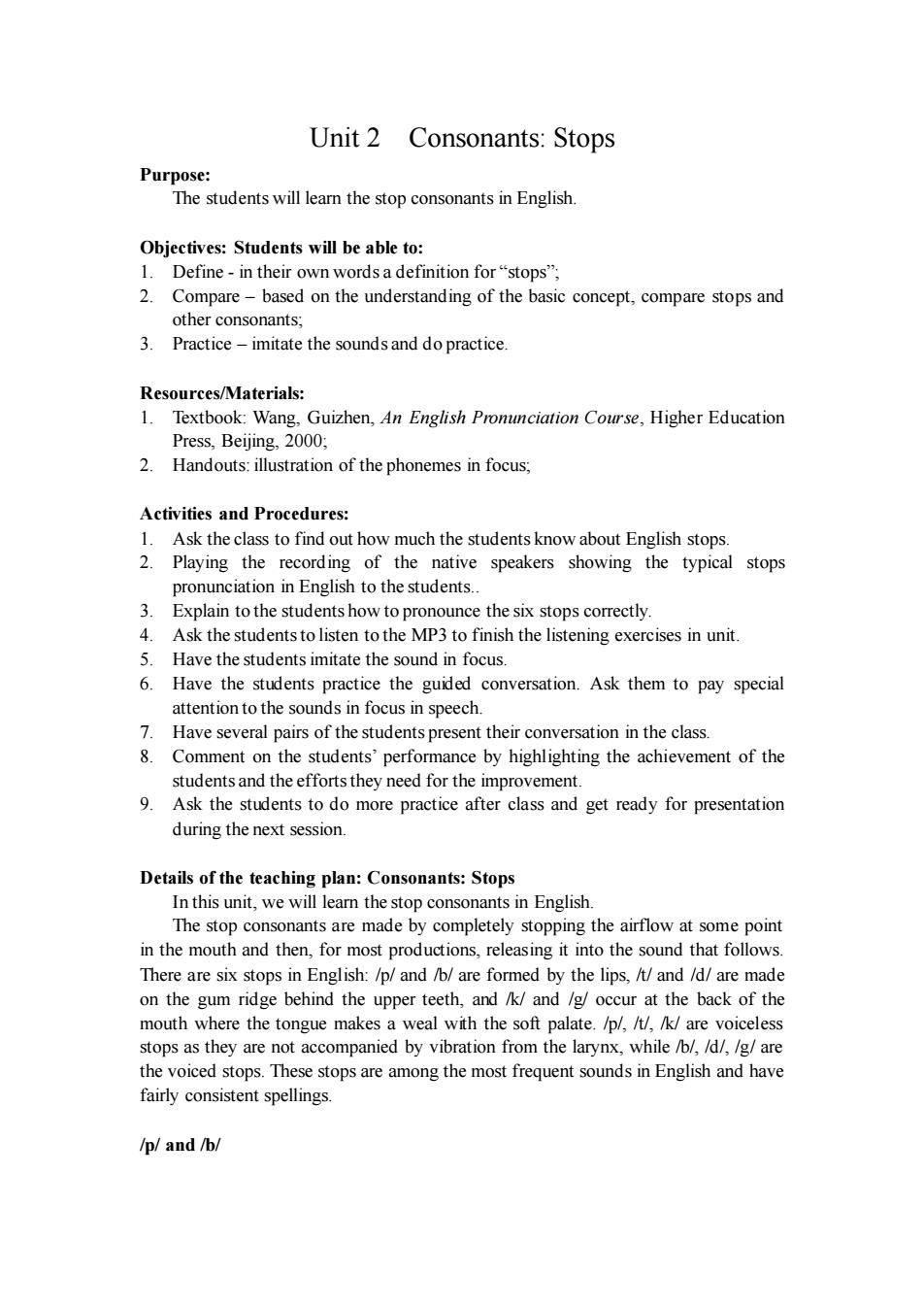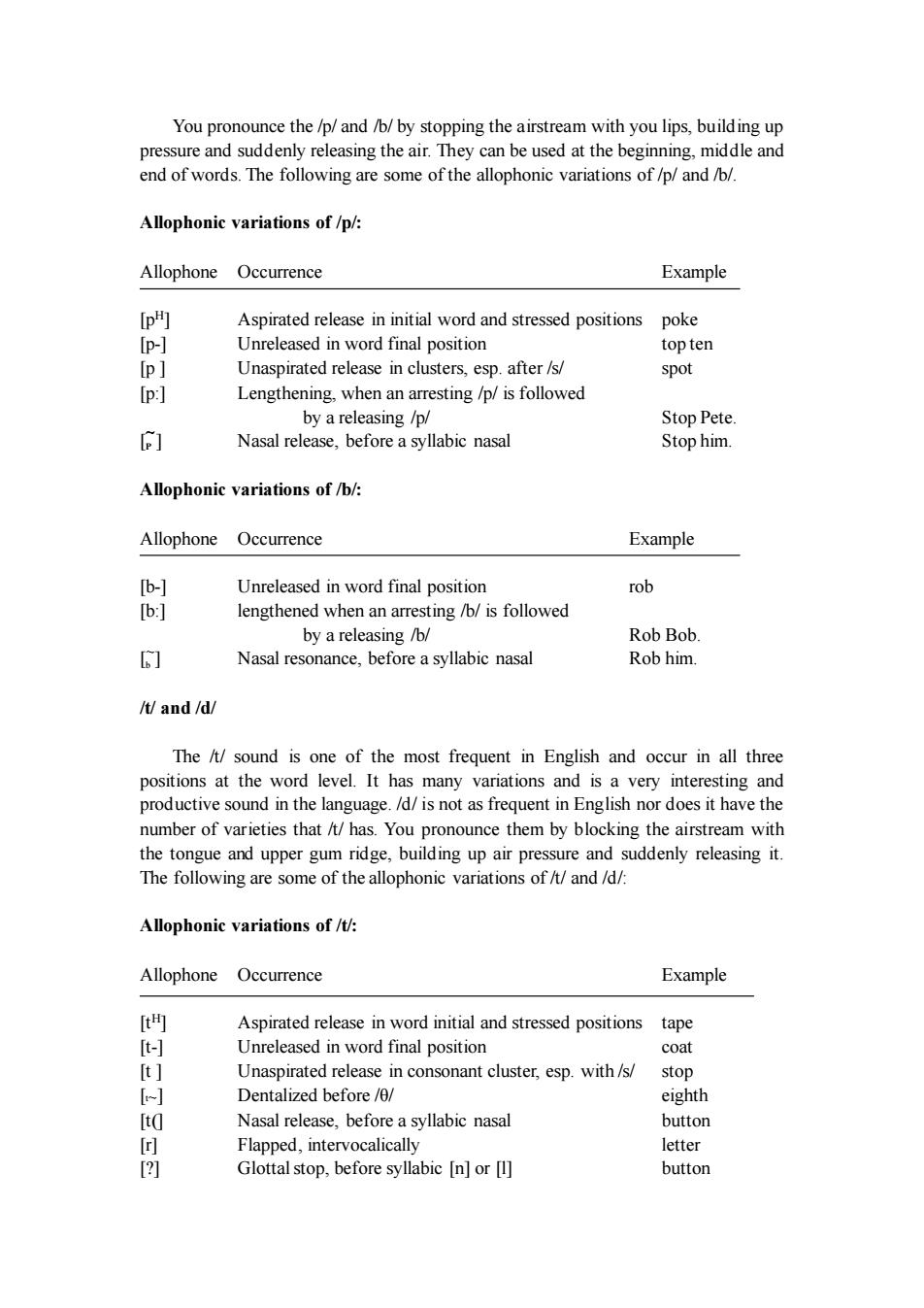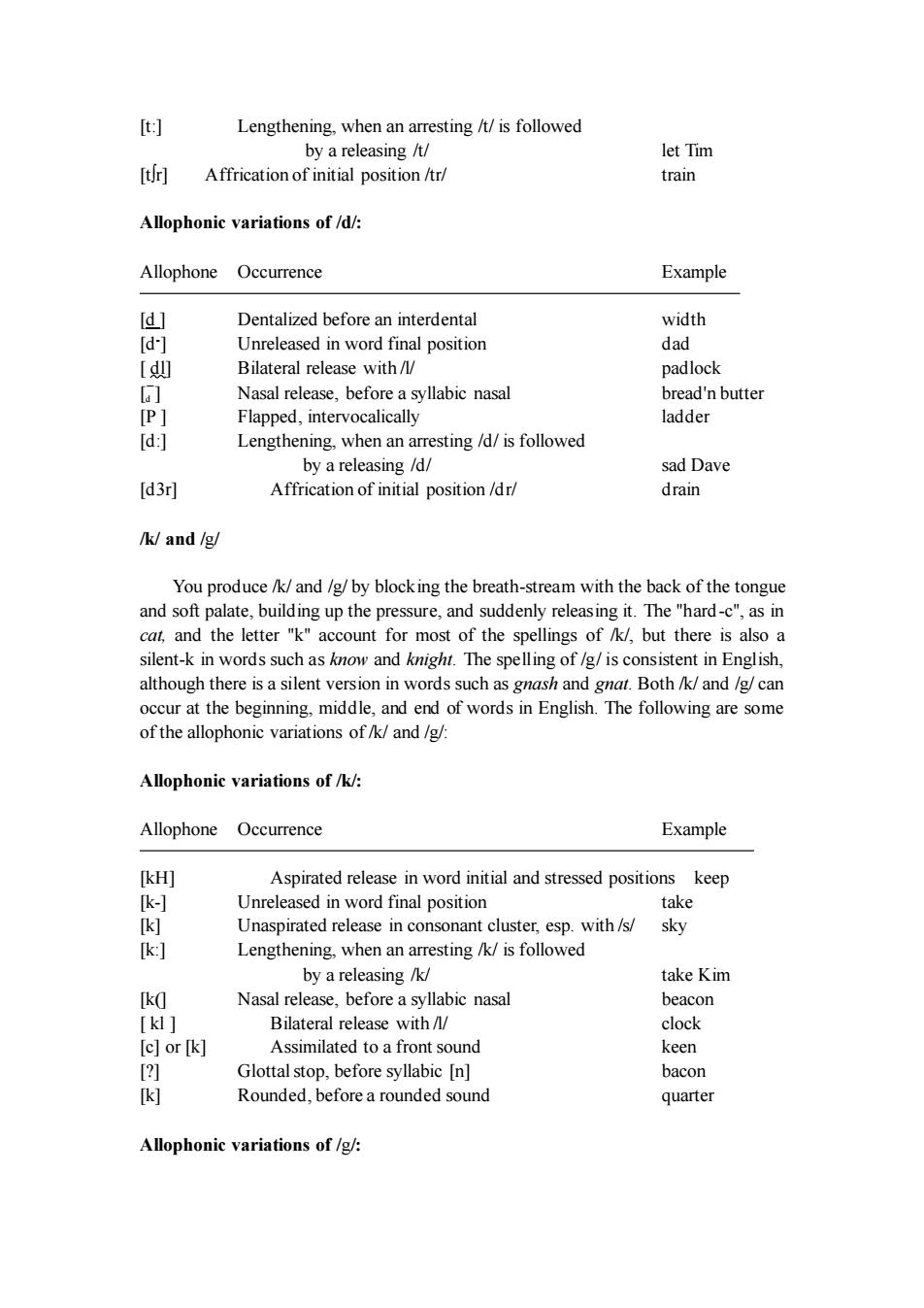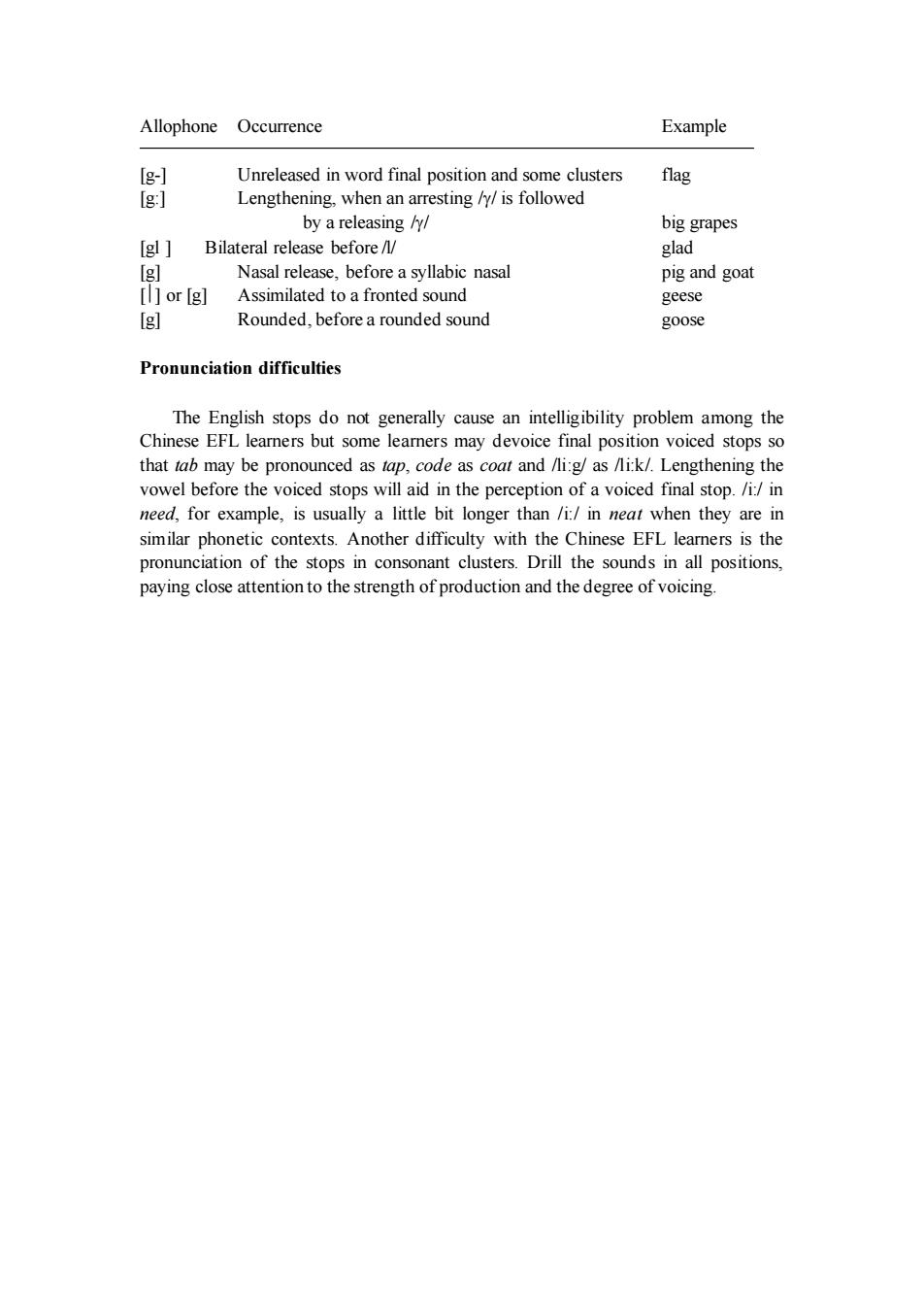
Unit 2 Consonants:Stops Purpose: The students will learn the stop consonants in English. Objectives:Students will be able to: 2. Compare -based on the understanding of the basic concept,compare stops and other consonants, 3.Practice-imitate the soundsand do practice. Resources/materials 1. Guizhen,An English Promnciation Couse,Higher Education Press,Beijing.2000 2.Handouts:illustration of the phonemes in focus; Activities and Procedures: Ask the lass to find out how much the studentsknow about English stops 2. Playing the recording of the native speakers showing the typical stops pronunciation in English to the students. 3. Explain to the students how to pronounce the six stops correctly. 4.Ask the students to listen to the MP3 to finish the listening exercises in unit. Have the students imitate the sound in focus. 6. Have the st dents practice the guided conversation.Ask them to pay specia attention to the sounds in focus in speech. 7. Have several pairs of the students present their conversation in the class. 8 Comment on the students'performance by highlighting the achievement of the students and the efforts they need for the improvement. Ask the stude o more practice after class d s and get ready for presentation during the next session. Details of the teaching plan:Consonants:Stops In this unit.we will learn the stop consonants in English. The stop e made by completely sopping the in the mouth and then,for most productions,releasing it into the sound that follow There are six stops in English:/p/and /b/are formed by the lips,/t/and /d/are made on the gum ridge behind the upper teeth,and /k/and /g/occur at the back of the mouth where the tongue makes a weal with the soft palate./p/,/t/,/k/are voiceless stops as they are not accompanied by vibration from the larynx,while /b/,/d/,/g/are voiced stops.These stops are among the most frequent sounds in English and have fairly consistent spellings. /p/and /b/
Unit 2 Consonants: Stops Purpose: The students will learn the stop consonants in English. Objectives: Students will be able to: 1. Define - in their own words a definition for “stops”; 2. Compare – based on the understanding of the basic concept, compare stops and other consonants; 3. Practice – imitate the sounds and do practice. Resources/Materials: 1. Textbook: Wang, Guizhen, An English Pronunciation Course, Higher Education Press, Beijing, 2000; 2. Handouts: illustration of the phonemes in focus; Activities and Procedures: 1. Ask the class to find out how much the students know about English stops. 2. Playing the recording of the native speakers showing the typical stops pronunciation in English to the students. 3. Explain to the students how to pronounce the six stops correctly. 4. Ask the students to listen to the MP3 to finish the listening exercises in unit. 5. Have the students imitate the sound in focus. 6. Have the students practice the guided conversation. Ask them to pay special attention to the sounds in focus in speech. 7. Have several pairs of the students present their conversation in the class. 8. Comment on the students’ performance by highlighting the achievement of the students and the efforts they need for the improvement. 9. Ask the students to do more practice after class and get ready for presentation during the next session. Details of the teaching plan: Consonants: Stops In this unit, we will learn the stop consonants in English. The stop consonants are made by completely stopping the airflow at some point in the mouth and then, for most productions, releasing it into the sound that follows. There are six stops in English: /p/ and /b/ are formed by the lips, /t/ and /d/ are made on the gum ridge behind the upper teeth, and /k/ and /g/ occur at the back of the mouth where the tongue makes a weal with the soft palate. /p/, /t/, /k/ are voiceless stops as they are not accompanied by vibration from the larynx, while /b/, /d/, /g/ are the voiced stops. These stops are among the most frequent sounds in English and have fairly consistent spellings. /p/ and /b/

pressure and suddenly releasing the air.They can be used at the beginning middle and end of words.The following are some of the allophonic variations of/p/and/b/. Allophonic variations of/p/: Allophone Occurrence Example p鬥 Aspirated release in initial word and stressed positions poke p- Unreleased in word final position topten [p Unaspirated release in clusters,esp.after/s/ spot p Lengthening.when an arresting /p/is followed by a releasing /p Stop Pete Nasal release,before a syllabic nasal Stop him. Allophonic variations of/b/: Allophone Occurrence Example [b-] Unreleased in word final position rob [b:] lengthened when an arresting /b/is followed by a releasing /b/ Rob Bob Nasal rese sonance,before a syllabic nasal Rob him. /t/and /d/ The /t/sound is one of the most frequent in English and occur in all three positions at the word many productive sound in the la number of varieties that /t/has.You pronounce them by blocking the airstream with the tongue and upper gum ridge,building up air pressure and suddenly releasing it. The following are some of the allophonic variations of/t/and/d/: Allophonic variations of /t/ Allophone Occurrence Example ftHI Aspirated release in word initial and stressed positions tape Unreleased in word final position t Unaspirated release n consonant cluster,esp.with/s/ stop o Dentalized before/ eighth to Nasal release,before a syllabic nasal button Flapped.intervocalically letter Glottal stop.before syllabic [n]or[] button
You pronounce the /p/ and /b/ by stopping the airstream with you lips, building up pressure and suddenly releasing the air. They can be used at the beginning, middle and end of words. The following are some of the allophonic variations of /p/ and /b/. Allophonic variations of /p/: Allophone Occurrence Example [p] Aspirated release in initial word and stressed positions poke [p-] Unreleased in word final position top ten [p ] Unaspirated release in clusters, esp. after /s/ spot [p:] Lengthening, when an arresting /p/ is followed by a releasing /p/ Stop Pete. [ ~ P ] Nasal release, before a syllabic nasal Stop him. Allophonic variations of /b/: Allophone Occurrence Example [b-] Unreleased in word final position rob [b:] lengthened when an arresting /b/ is followed by a releasing /b/ Rob Bob. [ ~ b ] Nasal resonance, before a syllabic nasal Rob him. /t/ and /d/ The /t/ sound is one of the most frequent in English and occur in all three positions at the word level. It has many variations and is a very interesting and productive sound in the language. /d/ is not as frequent in English nor does it have the number of varieties that /t/ has. You pronounce them by blocking the airstream with the tongue and upper gum ridge, building up air pressure and suddenly releasing it. The following are some of the allophonic variations of /t/ and /d/: Allophonic variations of /t/: Allophone Occurrence Example [t] Aspirated release in word initial and stressed positions tape [t-] Unreleased in word final position coat [t ] Unaspirated release in consonant cluster, esp. with /s/ stop [t~] Dentalized before /θ/ eighth [t(] Nasal release, before a syllabic nasal button [r] Flapped, intervocalically letter [] Glottal stop, before syllabic [n] or [l] button

Lengthening.when an arresting/t/is followed releasing 时 Affricationof initial position /r/ Allophonic variations of/d/: Allophone Occurrence Example @ Dentalized before an interdental width d Unreleased in word final position dad Bilateral release with// padlock Nasal release,before a syllabic nasal bread'n butter Flapped,intervocalically ladder ld:] Lengthening.when an arresting /d/is followed by a releasing /d/ sad Dave [d3r] Affrication of initial position/dr/ drain /k/and /g/ You produce /k/and /g/by blocking the breath-stream with the back of the tongue and soft palate,building up the pressure,and suddenly releasing it.The"hard-c",as in cat.and the letter "k"account for most of the spellings of /k/,but there is also a silent-k in words such as know and knight.The spelling of/g/is consistent in English, athough there is a silent ver at.Both/k/and /g/ca occur at the beginning,middle,and end of words in English.The following are some of the allophonic variations of/k/and/g/: Allophonic variations of/k/: Allophone Occurrence Example [kH] Aspirated release in word initial and stressed positions keep k-1 Unreleased in word final position take k Unaspirated release in consonant cluster,esp.with/s/sky Lengthening.when an arresting/k/is followed by a releasing /k/ take Kim [k Nasal release,before a syllabic nasal beacon [k] Bilateral release with// clock [c]or [k] Assimilated to a front sound keen Glottal stop,before syllabic bacor Rounded,beforea rounded sound quarter Allophonic variations of/g/:
[t:] Lengthening, when an arresting /t/ is followed by a releasing /t/ let Tim [t∫r] Affrication of initial position /tr/ train Allophonic variations of /d/: Allophone Occurrence Example [d ] Dentalized before an interdental width [d- ] Unreleased in word final position dad [ dl] Bilateral release with /l/ padlock [ - d ] Nasal release, before a syllabic nasal bread'n butter [ ] Flapped, intervocalically ladder [d:] Lengthening, when an arresting /d/ is followed by a releasing /d/ sad Dave [d3r] Affrication of initial position /dr/ drain /k/ and /g/ You produce /k/ and /g/ by blocking the breath-stream with the back of the tongue and soft palate, building up the pressure, and suddenly releasing it. The "hard-c", as in cat, and the letter "k" account for most of the spellings of /k/, but there is also a silent-k in words such as know and knight. The spelling of /g/ is consistent in English, although there is a silent version in words such as gnash and gnat. Both /k/ and /g/ can occur at the beginning, middle, and end of words in English. The following are some of the allophonic variations of /k/ and /g/: Allophonic variations of /k/: Allophone Occurrence Example [k] Aspirated release in word initial and stressed positions keep [k-] Unreleased in word final position take [k] Unaspirated release in consonant cluster, esp. with /s/ sky [k:] Lengthening, when an arresting /k/ is followed by a releasing /k/ take Kim [k(] Nasal release, before a syllabic nasal beacon [ kl ] Bilateral release with /l/ clock [c] or [k] Assimilated to a front sound keen [] Glottal stop, before syllabic [n] bacon [k] Rounded, before a rounded sound quarter Allophonic variations of /g/:

Allophone Occurrence Example [g-] Unreleased in word final position and some clusters flag [g] Lengthening.when an arresting /y/is followed by a releasing /y/ big grapes Igl 1 Bilateral release beforeA/ glad Nasal re lea pig and goat [l]or [g] Assimilated to a fronted sound geese g Rounded,before a rounded sound goose Pronunciation difficulties The English stops do not generally cause an intelligibility problem among the Chinese EFL learners but some leamners may devoice final position voiced stops so that tab may be pronounced as tap,code as coat and /li:g/as /i:k/.Lengthening the vowel before the voiced stops will aid in the perception of a voiced final stop./i/in need,for example,is usually a little bit longer than /i:/in neat when they are in ntexts.Another difficulty with the Chinese EFL leamers is the pronunciation of the stops in consonant clusters.Drill the sounds in all positions. paying close attention to the strength of production and the degree of voicing
Allophone Occurrence Example [g-] Unreleased in word final position and some clusters flag [g:] Lengthening, when an arresting // is followed by a releasing // big grapes [gl ] Bilateral release before /l/ glad [g] Nasal release, before a syllabic nasal pig and goat [] or [g] Assimilated to a fronted sound geese [g] Rounded, before a rounded sound goose Pronunciation difficulties The English stops do not generally cause an intelligibility problem among the Chinese EFL learners but some learners may devoice final position voiced stops so that tab may be pronounced as tap, code as coat and /li:g/ as /li:k/. Lengthening the vowel before the voiced stops will aid in the perception of a voiced final stop. /i:/ in need, for example, is usually a little bit longer than /i:/ in neat when they are in similar phonetic contexts. Another difficulty with the Chinese EFL learners is the pronunciation of the stops in consonant clusters. Drill the sounds in all positions, paying close attention to the strength of production and the degree of voicing